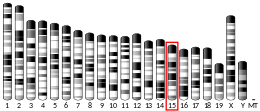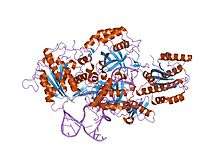Ku70
Ku70 is a protein that, in humans, is encoded by the XRCC6 gene.[5][6]
Function
Together, Ku70 and Ku80 make up the Ku heterodimer, which binds to DNA double-strand break ends and is required for the non-homologous end joining (NHEJ) pathway of DNA repair. It is also required for V(D)J recombination, which utilizes the NHEJ pathway to promote antigen diversity in the mammalian immune system.
In addition to its role in NHEJ, Ku is also required for telomere length maintenance and subtelomeric gene silencing.[7]
Ku was originally identified when patients with systemic lupus erythematosus were found to have high levels of autoantibodies to the protein.[5]
Aging
Mouse embryonic stem cells with homozygous Ku70 mutations, that is Ku70−/− cells, have markedly increased sensitivity to ionizing radiation compared to heterozygous Ku70+/− or wild-type Ku70+/+ embryonic stem cells.[8] Mutant mice deficient in Ku70 exhibit early aging.[9] Using several specific criteria of aging, the mutant mice were found to display the same aging signs as control mice, but at a considerably earlier chronological age. These results suggest that reduced ability to repair DNA double-strand breaks causes early aging, and that the wild-type Ku70 gene plays an important role in longevity assurance.[10] (Also see DNA damage theory of aging.)
Clinical
A mutation in this gene has been described in a set of 24 families with autism.[11] While this is suggestive that this gene may play a role in the development of autism, further investigation is required.
Nomenclature
Ku70 has been referred to by several names including:
- Lupus Ku autoantigen protein p70
- ATP-dependent DNA helicase 2 subunit 1
- X-ray repair complementing defective repair in Chinese hamster cells 6
- X-ray repair cross-complementing 6 (XRCC6)
Interactions
Ku70 has been shown to interact with:
References
- GRCh38: Ensembl release 89: ENSG00000196419 - Ensembl, May 2017
- GRCm38: Ensembl release 89: ENSMUSG00000022471 - Ensembl, May 2017
- "Human PubMed Reference:". National Center for Biotechnology Information, U.S. National Library of Medicine.
- "Mouse PubMed Reference:". National Center for Biotechnology Information, U.S. National Library of Medicine.
- "Entrez Gene: XRCC6 X-ray repair complementing defective repair in Chinese hamster cells 6 (Ku autoantigen, 70kDa)".
- Pace P, Mosedale G, Hodskinson MR, Rosado IV, Sivasubramaniam M, Patel KJ (Jul 2010). "Ku70 corrupts DNA repair in the absence of the Fanconi anemia pathway". Science. 329 (5988): 219–23. doi:10.1126/science.1192277. PMID 20538911.
- Boulton SJ, Jackson SP (Mar 1998). "Components of the Ku-dependent non-homologous end-joining pathway are involved in telomeric length maintenance and telomeric silencing". The EMBO Journal. 17 (6): 1819–28. doi:10.1093/emboj/17.6.1819. PMC 1170529. PMID 9501103.
- Gu Y, Jin S, Gao Y, Weaver DT, Alt FW (Jul 1997). "Ku70-deficient embryonic stem cells have increased ionizing radiosensitivity, defective DNA end-binding activity, and inability to support V(D)J recombination". Proceedings of the National Academy of Sciences of the United States of America. 94 (15): 8076–81. doi:10.1073/pnas.94.15.8076. PMC 21559. PMID 9223317.
- Li H, Vogel H, Holcomb VB, Gu Y, Hasty P (Dec 2007). "Deletion of Ku70, Ku80, or both causes early aging without substantially increased cancer". Molecular and Cellular Biology. 27 (23): 8205–14. doi:10.1128/MCB.00785-07. PMC 2169178. PMID 17875923.
- Bernstein H, Payne CM, Bernstein C, Garewal H, Dvorak K (2008). Cancer and aging as consequences of un-repaired DNA damage. In: New Research on DNA Damages (Editors: Honoka Kimura and Aoi Suzuki) Nova Science Publishers, Inc., New York, Chapter 1, pp. 1-47. open access, but read only https://www.novapublishers.com/catalog/product_info.php?products_id=43247 Archived 2014-10-25 at the Wayback Machine ISBN 978-1604565812
- Sjaarda CP, Wood S, McNaughton AJ, Taylor S, Hudson ML, Liu X, Guerin A, Ayub M (December 2019). "Exome sequencing identifies de novo splicing variant in XRCC6 in sporadic case of autism". Journal of Human Genetics. doi:10.1038/s10038-019-0707-0. PMID 31827253.
- Song K, Jung Y, Jung D, Lee I (Mar 2001). "Human Ku70 interacts with heterochromatin protein 1alpha". The Journal of Biological Chemistry. 276 (11): 8321–7. doi:10.1074/jbc.M008779200. PMID 11112778.
- Goudelock DM, Jiang K, Pereira E, Russell B, Sanchez Y (Aug 2003). "Regulatory interactions between the checkpoint kinase Chk1 and the proteins of the DNA-dependent protein kinase complex". The Journal of Biological Chemistry. 278 (32): 29940–7. doi:10.1074/jbc.M301765200. PMID 12756247.
- Barlev NA, Poltoratsky V, Owen-Hughes T, Ying C, Liu L, Workman JL, Berger SL (Mar 1998). "Repression of GCN5 histone acetyltransferase activity via bromodomain-mediated binding and phosphorylation by the Ku-DNA-dependent protein kinase complex". Molecular and Cellular Biology. 18 (3): 1349–58. doi:10.1128/mcb.18.3.1349. PMC 108848. PMID 9488450.
- Schild-Poulter C, Pope L, Giffin W, Kochan JC, Ngsee JK, Traykova-Andonova M, Haché RJ (May 2001). "The binding of Ku antigen to homeodomain proteins promotes their phosphorylation by DNA-dependent protein kinase". The Journal of Biological Chemistry. 276 (20): 16848–56. doi:10.1074/jbc.M100768200. PMID 11279128.
- Gell D, Jackson SP (Sep 1999). "Mapping of protein-protein interactions within the DNA-dependent protein kinase complex". Nucleic Acids Research. 27 (17): 3494–502. doi:10.1093/nar/27.17.3494. PMC 148593. PMID 10446239.
- Yang CR, Yeh S, Leskov K, Odegaard E, Hsu HL, Chang C, Kinsella TJ, Chen DJ, Boothman DA (May 1999). "Isolation of Ku70-binding proteins (KUBs)". Nucleic Acids Research. 27 (10): 2165–74. doi:10.1093/nar/27.10.2165. PMC 148436. PMID 10219089.
- Singleton BK, Torres-Arzayus MI, Rottinghaus ST, Taccioli GE, Jeggo PA (May 1999). "The C terminus of Ku80 activates the DNA-dependent protein kinase catalytic subunit" (PDF). Molecular and Cellular Biology. 19 (5): 3267–77. doi:10.1128/mcb.19.5.3267. PMC 84121. PMID 10207052.
- Song K, Jung D, Jung Y, Lee SG, Lee I (Sep 2000). "Interaction of human Ku70 with TRF2". FEBS Letters. 481 (1): 81–5. doi:10.1016/S0014-5793(00)01958-X. PMID 10984620.
- Goedecke W, Eijpe M, Offenberg HH, van Aalderen M, Heyting C (Oct 1999). "Mre11 and Ku70 interact in somatic cells, but are differentially expressed in early meiosis". Nature Genetics. 23 (2): 194–8. doi:10.1038/13821. PMID 10508516.
- Ko L, Cardona GR, Chin WW (May 2000). "Thyroid hormone receptor-binding protein, an LXXLL motif-containing protein, functions as a general coactivator". Proceedings of the National Academy of Sciences of the United States of America. 97 (11): 6212–7. doi:10.1073/pnas.97.11.6212. PMC 18584. PMID 10823961.
- Ko L, Chin WW (Mar 2003). "Nuclear receptor coactivator thyroid hormone receptor-binding protein (TRBP) interacts with and stimulates its associated DNA-dependent protein kinase". The Journal of Biological Chemistry. 278 (13): 11471–9. doi:10.1074/jbc.M209723200. PMID 12519782.
- Grandvaux N, Grizot S, Vignais PV, Dagher MC (Feb 1999). "The Ku70 autoantigen interacts with p40phox in B lymphocytes". Journal of Cell Science. 112 (4): 503–13. PMID 9914162.
- Ohta S, Shiomi Y, Sugimoto K, Obuse C, Tsurimoto T (Oct 2002). "A proteomics approach to identify proliferating cell nuclear antigen (PCNA)-binding proteins in human cell lysates. Identification of the human CHL12/RFCs2-5 complex as a novel PCNA-binding protein". The Journal of Biological Chemistry. 277 (43): 40362–7. doi:10.1074/jbc.M206194200. PMID 12171929.
- Balajee AS, Geard CR (Mar 2001). "Chromatin-bound PCNA complex formation triggered by DNA damage occurs independent of the ATM gene product in human cells". Nucleic Acids Research. 29 (6): 1341–51. doi:10.1093/nar/29.6.1341. PMC 29758. PMID 11239001.
- Romero F, Multon MC, Ramos-Morales F, Domínguez A, Bernal JA, Pintor-Toro JA, Tortolero M (Mar 2001). "Human securin, hPTTG, is associated with Ku heterodimer, the regulatory subunit of the DNA-dependent protein kinase". Nucleic Acids Research. 29 (6): 1300–7. doi:10.1093/nar/29.6.1300. PMC 29753. PMID 11238996.
- Shao RG, Cao CX, Zhang H, Kohn KW, Wold MS, Pommier Y (Mar 1999). "Replication-mediated DNA damage by camptothecin induces phosphorylation of RPA by DNA-dependent protein kinase and dissociates RPA:DNA-PK complexes". The EMBO Journal. 18 (5): 1397–406. doi:10.1093/emboj/18.5.1397. PMC 1171229. PMID 10064605.
- Chai W, Ford LP, Lenertz L, Wright WE, Shay JW (Dec 2002). "Human Ku70/80 associates physically with telomerase through interaction with hTERT". The Journal of Biological Chemistry. 277 (49): 47242–7. doi:10.1074/jbc.M208542200. PMID 12377759.
- Romero F, Dargemont C, Pozo F, Reeves WH, Camonis J, Gisselbrecht S, Fischer S (Jan 1996). "p95vav associates with the nuclear protein Ku-70". Molecular and Cellular Biology. 16 (1): 37–44. doi:10.1128/mcb.16.1.37. PMC 230976. PMID 8524317.
- Karmakar P, Snowden CM, Ramsden DA, Bohr VA (Aug 2002). "Ku heterodimer binds to both ends of the Werner protein and functional interaction occurs at the Werner N-terminus". Nucleic Acids Research. 30 (16): 3583–91. doi:10.1093/nar/gkf482. PMC 134248. PMID 12177300.
- Li B, Comai L (Sep 2000). "Functional interaction between Ku and the werner syndrome protein in DNA end processing". The Journal of Biological Chemistry. 275 (37): 28349–52. doi:10.1074/jbc.C000289200. PMID 10880505.
Further reading
- Smider V, Chu G (Jun 1997). "The end-joining reaction in V(D)J recombination". Seminars in Immunology. 9 (3): 189–97. doi:10.1006/smim.1997.0070. PMID 9200330.
- Featherstone C, Jackson SP (May 1999). "Ku, a DNA repair protein with multiple cellular functions?". Mutation Research. 434 (1): 3–15. doi:10.1016/s0921-8777(99)00006-3. PMID 10377944.
- Koike M (Sep 2002). "Dimerization, translocation and localization of Ku70 and Ku80 proteins". Journal of Radiation Research. 43 (3): 223–36. doi:10.1269/jrr.43.223. PMID 12518983.
External links
- PDBe-KB provides an overview of all the structure information available in the PDB for Human X-ray repair cross-complementing protein 6






